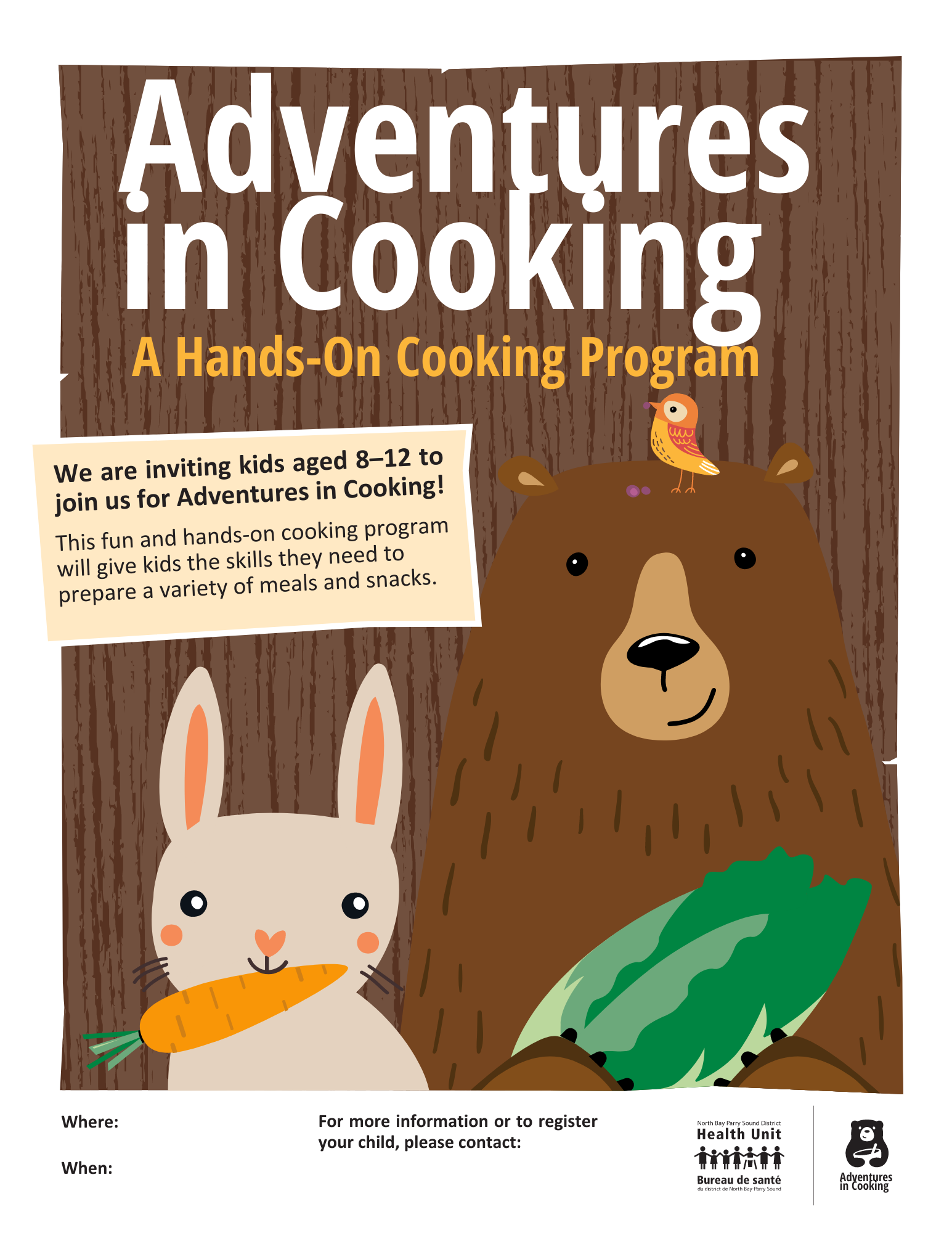Welcome to Adventures in Cooking!
In today’s world, we are surrounded by convenience foods and many families don’t cook homemade meals anymore. Cooking skills are not being handed down to our kids the way they were in the past, which is why it’s so important to give kids the opportunity to learn basic cooking skills in a fun and safe environment.
As you work with your group of kids to pass on the basic skills of preparing food, you are also reinforcing the importance of healthy eating.
The Adventures in Cooking program was designed for use with children aged 8 to 12 years (or grade 4 to 7). We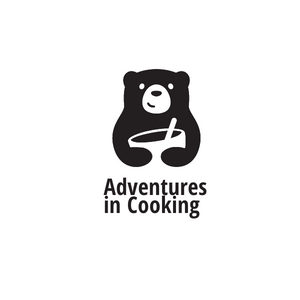 recommend groups of five children per fearless leader. Each cooking session can be tailored to your needs (e.g., budget, time available, group size).
recommend groups of five children per fearless leader. Each cooking session can be tailored to your needs (e.g., budget, time available, group size).
The sessions are designed to meet the following objectives:
- Provide children with the opportunity to learn:
- The skills to prepare homemade meals and snacks
- How to use a variety of kitchen tools and equipment
- Simple cooking terms and techniques
- Food safety basics
- Kitchen safety basics
- Discover traditional dishes of various cultures
- Encourage healthy eating with a focus on vegetables and fruit
- Inspire children with new flavours
- Have fun!
Tips for Leaders
Review the manual.
Before starting out, we recommend that you review this manual to get a feel for the program and to find out what you will need. Leading a cooking class for kids can be a bit hectic at times, but the program is designed to make the process as easy and fun as possible.
Advertise Your Program |
|
Here is a sample poster and registration form that you can adapt for your program. |
Equipment and Ingredients |
|
The program’s recipe collection uses common kitchen equipment. You can find the full list in the Helpful Extras. Each recipe also lists what equipment is needed and suggests options if more than one piece of equipment can be used to perform a task. The selected ingredients for the recipe collection are ones you can find in grocery stores. Please remember you might have to substitute ingredients sometimes. Every store has a different selection. In the Helpful Extras, you can find an ingredient substitution list that can help guide you. You can also utilize other tools like the internet to find substitution ideas. |
Foods from the land, water and sky |
|
In Northern Ontario, the use of wild caught, foraged, and hunted foods play an important role in the culture of Indigenous and non-Indigenous people. Throughout this program’s recipe collection, there are opportunities to include these foods.
It is important to cook any meat to the appropriate internal temperature including wild game; see temperature chart in the Helpful Extras. |
Setting Up |
|
Make copies of the recipes for children to take home. Consider putting them in a folder or binder for each participant.
Bleach and water at a concentration of 100 ppm; Mix 1 tsp (5 mL) plain household bleach and 3 cups of water in a spray bottle Quaternary ammonia “Quat” sanitizer solutions at a concentration of 200 ppm; or Other sanitization products may be considered. Please consult with your local public health unit before use.
|
Learning by Doing |
|
The sessions are designed for kids to work together to make each recipe. This way, everyone gets a chance to do everything from cutting to measuring to cooking. Many children do not know the names of simple cooking tools and preparation terms. These sessions are a great way to learn cooking terms and practice using different kitchen equipment. See the list of cooking terms and their meanings as well as a visual equipment list in the Helpful Extras. Give participants more independence as they go through the sessions so they can gradually improve their skills, while you remain present to supervise and help out where needed. At the end of your session(s), give each participant a certificate to congratulate them on their hard work and skill development. You can find the certificate in the Helpful Extras. |
Key Messages and Tips |
|
Each recipe section has key messages that can be used as time allows. These messages can be discussed during snack, embedded throughout recipe preparation, or talked about while the group eats together. Each recipe includes cultural, culinary and other tips that can be used as teaching moments during recipe preparation. These are also meant to guide kids when they recreate the recipes at home. |
Learning by Playing |
|
Cooking is a fun activity. Make it even more fun by including other activities during your session. Here is a list of the program’s Activities and what recipe(s) we suggest doing them based on relevance and time.
|
Talking About Food In a Positive Way |
|
Try to not talk about foods as healthy or unhealthy, since this sends the message that some foods are good and some are bad. All foods fit in a healthy eating pattern. Instead of focusing on the health benefits of a food, encourage kids to explore the food using their five senses, talk about how the food is grown or produced, and discuss what recipes can be made with the food. |
Creating an Inclusive Space |
|
The focus of Adventures in Cooking is on cooking and exploring food. However, the subject of weight and dieting often comes up when talking about food. Conversations or comments about dieting and weight should be steered back towards a focus on healthy living, for example, exploring new foods, eating meals and snacks with others, getting enough sleep, and doing activities that you enjoy. It’s important to emphasize that healthy bodies come in different shapes and sizes. Do your best to create a kitchen where all bodies are accepted and making comments about appearance is not tolerated. |
Learning and Teaching Moments |
|
Each recipe includes various tips that can be shared with the kids during recipe preparation. These tips are meant to provide further information to enhance kids' learning and experience. These are also meant to guide kids when they recreate the recipes at home. Meals and snacks
Food literacy skills
Cultural dishes
Hunger and thirst cues
|
Food Allergies |
|
Pay close attention to the registration form and any food allergies that are listed. We recommend that you discuss any food allergies with the child’s caregiver. If you are unsure about certain ingredients, you can contact a dietitian at your local health unit. |
Kitchen Safety |
|
Food Safety |
|
We strongly encourage all leaders get their Food Handler Training certificate before delivering Adventures in Cooking. If you are receiving training from the health unit to deliver this program, the fee for Food Handler’s training may be covered. Please notify the Environmental Health Department at your local public health unit about your program. They can provide a consultation to ensure your cooking facility is equipped to run the program. |
Cleaning up Body Fluids |
|
Avoid direct contact with body fluids (e.g., urine, feces, vomit, blood), as they all have the potential to spread germs. Germs in vomit and diarrhea may travel through the air, so it is very important to clean it up quickly. The following is a good procedure to use:
|
Session Outline
Preparation |
|
Select a session theme (for example, Beary Best Breakfasts) and pick the recipes from the recipe bank(s). Themes could be based on seasonal ingredients, celebrations and important dates, recipe types, or mealtimes. If you wish, use the Planning Worksheet in the Helpful Extras to guide you through the process of preparing for your session. Use it as a quick reference for your shopping list, equipment needed, dietary restrictions of participants, and |
Set Up |
|
1. Before the children arrive, prepare a snack and put out cups with a pitcher of water to have available during the session. 2. Set up equipment and ingredients according to your selected recipes. 3. Print recipes to send home with children. 4. Have hair elastics or hairnets available for children to confine hair. They can also use their own ball cap or bandana. |
Snack Time and Ground Rules |
|
While the children eat their snack and get settled, set ground rules to create a positive and safe environment. Post them in the kitchen to refer to if participants need a reminder. Ask participants what they think should be included. Examples may include: • Everyone has something to learn and something to contribute • Listen to the leaders • Be kind to one another • Always treat food and kitchen equipment with respect • Wash your hands often • No running in the kitchen • Keep hands to yourself • Have fun! |
Recipe Review |
| As a group, review the selected recipes in detail. If necessary, divide children into groups depending on the number of recipes, participants and allocated time for your session. |
Let's Cook! |
| Have the participants:
1. Confine their hair with an elastic or hair net. They can also use their own ball cap or bandana. 2. Wash their hands. Refer to the Activities for a handwashing game. 3. Put on an apron after hands are clean. 4. Divide into their recipe groups (if dividing them up). 5. Start cooking! |
Let's Eat! |
|
Ensure that children wash their hands before handling clean dishes. Teach the children how to set the table (see Table Setting Placemat in the Helpful Extras) and discuss the importance of table manners. |
Let's Clean Up! |
|
As the children finish eating, ask them to bring their own dishes to the dishwashing area. If needed, assign tasks for clean-up. Duties include washing, rinsing and sanitizing dishes, wiping the table and counters, sweeping the floor and putting away ingredients, equipment, and clean dishes. Try to clean and sanitize as you go to prevent a pile of dishes at the |
Recipes

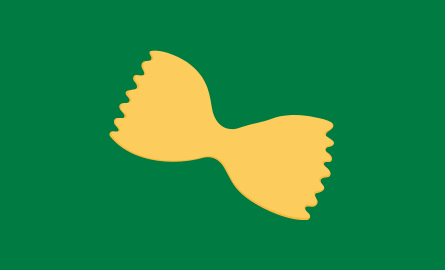
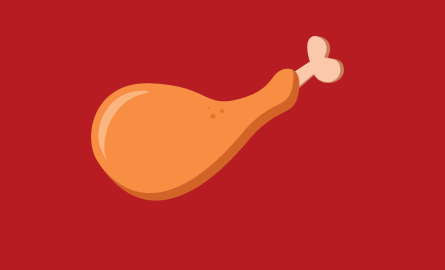

The Adventures in Cooking program was jointly updated by the North Bay Parry Sound District Health Unit, Public Health Sudbury & Districts, and the Thunder Bay District Health Unit.

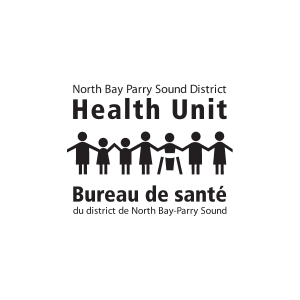
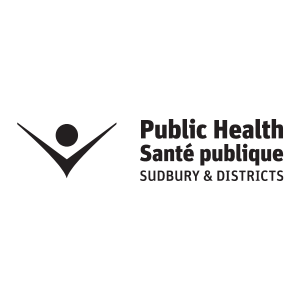

You may also like:
- Community Kitchen Resources
- Teaching Kitchen: Book the Teaching Kitchen in North Bay
- Feeding Your School-Aged Child
- Food Safety



